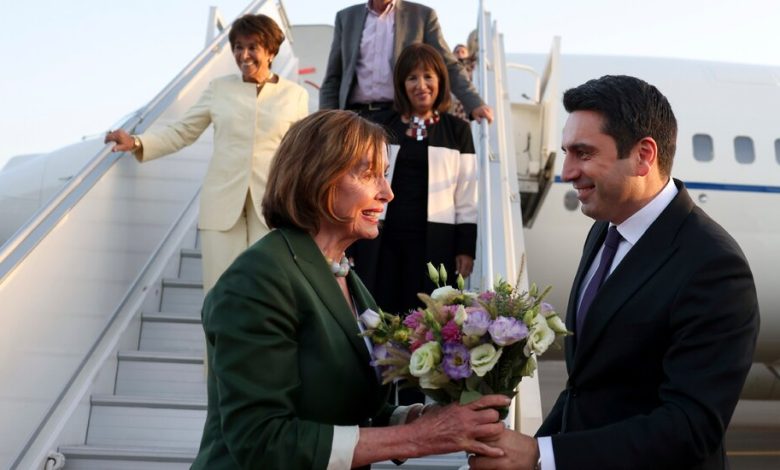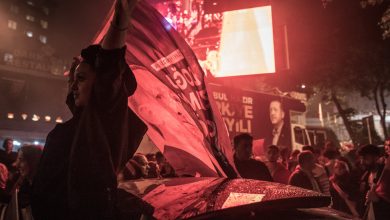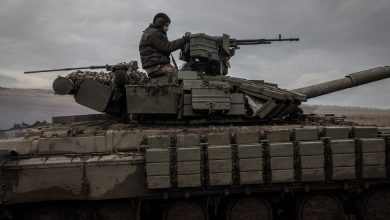Nancy Pelosi Visits Armenia Amid Conflict With Azerbaijan

LONDON — Speaker Nancy Pelosi arrived in Armenia on Saturday, leading a congressional delegation in a show of support for the small south Caucasus nation after an outbreak of fighting with neighboring Azerbaijan resulted in the deaths of more than 200 people this week.
Ms. Pelosi said that she would meet with Prime Minister Nikol Pashinyan in the capital, Yerevan, as well as with other officials to convey “the strong and ongoing support of the United States” for Armenia and for a lasting settlement to the conflict between the two neighbors over the disputed territory of Nagorno-Karabakh.
The trip was seen as a political move by Ms. Pelosi ahead of the midterm elections in November. She is the highest-ranking American official to visit Armenia since it gained independence 30 years ago with the end of the Soviet Union, her office said in a statement. She was accompanied by Representatives Jackie Speier and Anna G. Eshoo, both Armenian Americans from California, where there is a large Armenian community.
The visit, Ms. Pelosi’s latest effort to flex the legislative branch’s diplomatic muscle, comes amid an eruption of war in Europe and points to the shifting balance of power around the former Soviet empire where the United States has long sought to build influence. The recent fighting in Nagorno-Karabakh is the worst since a full-scale war there killed thousands in 2020, and it has made Armenia appear particularly vulnerable.
Russia, Armenia’s longtime protector, has been weakened by an unexpectedly difficult war in Ukraine, and Azerbaijan has aggressively pushed Mr. Pashinyan to agree to a peace deal that would recognize Azerbaijani sovereignty over the disputed territory.
The State of the War
- Dramatic Gains for Ukraine: After Ukraine’s offensive in the country’s northeast drove Russian forces into a chaotic retreat, Ukrainian leaders face critical choices on how far to press the attack.
- In Izium: Following Russia’s retreat, Ukrainian investigators have begun documenting the toll of Russian occupation on the northeastern city. They have already found several burial sites, including one that could hold the remains of more than 400 people.
- Southern Counteroffensive: Military operations in the south have been a painstaking battle of river crossings, with pontoon bridges as prime targets for both sides. So far, it is Ukraine that has advanced.
- An Inferno in Mykolaiv: The southern Ukrainian city has been a target of near-incessant shelling since the war began. Firefighters are risking their lives to save as much of it as possible.
Azerbaijan has grown rich from developing oil and gas reserves after independence and built up a well-equipped army. It has been careful to maintain strong ties with Moscow, while developing an ally in the region in Turkey, a NATO member, which has had a historically hostile relationship with Armenia. Turkey and Armenia do not maintain official diplomatic relations.
Mr. Pashinyan has declared his intention to agree to a peace deal with Azerbaijan but is under intense pressure at home by opponents who have called such a deal treasonous.
Clashes blew up on Tuesday, with both sides trading artillery and mortars across their shared border. Azerbaijan accused Armenia of carrying out “severe provocations,” and Armenia complained that Azerbaijan had attacked deep into its territory. Russia brokered a cease-fire within hours, but clashes continued into a third day. American officials helped secure a truce, analysts said.
“The situation remains fragile,” Olesya Vartanyan, a senior analyst on the South Caucasus with the International Crisis Group, said on Saturday. Armenia was reporting that Azerbaijani troops were inside its territory, including only a short distance from one of its towns and near several villages along the border with Azerbaijan, she said.
“The Armenian side does not seem to have a capacity to arrange a proper military defense to avoid having the Azerbaijani troops marching deeper into its territory,” she said. “A small incident can provoke renewed fighting.”
Mr. Pashinyan said on Friday at a government meeting that Armenia had lost 135 soldiers in Azerbaijani attacks in recent days, adding that the number of dead was expected to rise as many of the wounded succumbed to injuries. Azerbaijan announced on Tuesday that it had lost 50 men from its army and border force on the first day.
Ms. Pelosi, the third highest-ranking official in the U.S. government, has recently inserted herself at the center of some of the world’s most heated conflicts. In May, she visited Kyiv, Ukraine’s capital, and met with President Volodymyr Zelensky, and in August, she traveled to Taiwan, infuriating China.
“Speaker Pelosi appears to be trying to flex the U.S. Congress’s diplomatic muscles and intervene in a bilateral regional conflict, perhaps without close coordination with the executive branch, as when she recently visited Taiwan,” said Matthew Bryza, a former American ambassador to Azerbaijan.
But she was visiting only one side of the conflict, he said. Ms. Pelosi was characterizing her visit as an effort to support human rights and the dignity of all people, and was, he said, “reflecting the Armenian government’s contention that Azerbaijan sparked this latest round of fighting.”
American officials have been working hard to bring Azerbaijan and Armenia back to negotiations, said Zaur Shiriyev, a South Caucasus analyst for the International Crisis Group in Baku, Azerbaijan, but if Ms. Pelosi’s intervention unbalanced those efforts, “then U.S. diplomatic efforts will not be perceived positively in Baku,” he said.





